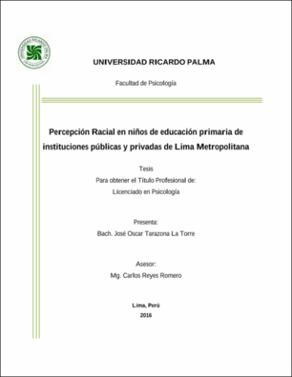| dc.description.abstract | La percepción racial, definida como la forma en que una persona interpreta a otra de una diferente etnia racial, nos ayuda a entender el aprendizaje sobre las diferentes razas que los niños tienen a corta edad y saber si sobre ésta predominan aspectos positivos o negativos en su expresión. Los participantes (n= 65; 33 mujeres y 32 hombres), de edades entre 6 y 7 años, de primer grado de primaria de dos centros educativos diferentes (estatal y particular), fueron expuestos a la presencia de dos muñecos de diferente etnia racial (raza blanca y raza negra) y a preguntas para poder determinar sus preferencias sobre estos. Resultados obtenidos reflejan que hay una alta preferencia de los participantes hacia el muñeco de raza blanca, además de una alta identificación con su color a pesar de los participantes ser de raza mestiza, además hay tendencia de atribuir al muñeco de raza negra aspectos negativos. La percepción de los participantes hacia el muñeco negro corresponde el ser feo, ser malo, pobre, poco estudioso, mientras que por el blanco corresponde el ser bueno, bonito, millonario, estudioso. Por lo que se puede discutir en los resultados, es que se observa que la percepción racial a esta edad ya es inadecuada debido a la atribución negativa que se hace sobre los muñecos de raza negra, lo que puede condicionar las actitudes que se tengan sobre esta raza. The racial perception, defined as the way a person interprets another of a different racial ethnicity, helps us to understand learning about the different races that children are at a young age and whether this expression are predominantly positive or negative. Participants (n = 65; 33 women and 32 men) aged between 6 and 7 years, from first grade of two different schools (public and private), were exposed to the presence of two dolls of different racial ethnicity (white and black) and questioned to determine their preference over them. Results show that there is a high preference of participants to the white doll, along with a high identification with their color despite the participants being of mixed race; in addition, there is a tendency to attribute negatives concepts to the black doll. The perception of the participants on the black doll corresponds being ugly, bad, poor, little studious, while to the white doll corresponds being good, beautiful, millionaire, studious. As can be discuss in the results, it is shows that the racial perception at this age is already inadequate by negative attribution on the black dolls, which can influence the attitudes on this race. | es_ES |

